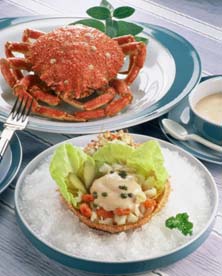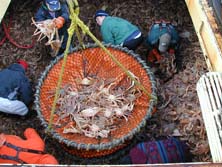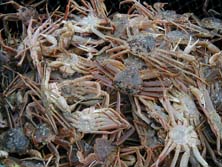Alaska Snow Crab (Chionoecetes opilio)
- Snow crab population levels are rebuilding, and overfishing is not occurring.
- Snow crab are managed using quotas that include shares specifically for Alaska communities.
- Crab provides many dietary benefits including a low-fat source of protein. For more on nutrition, see Nutrition Facts. (USDA)
- Snow crab landings were 34.1 million pounds in 2007, valued at over $50 million.
|
 |
 |
 |
 |
| Nutrition Facts |
| Servings 1 |
| Serving Weight
100 g |
 |
| Amount Per Serving |
 |
| Calories 90 |
 |
| Total Fat |
1.18 g |
 |
| Total Saturated Fatty Acids |
0.143 g |
 |
| Carbohydrate |
0 g |
| Sugars |
0 g |
| Total Dietary
Fiber |
0 g |
 |
| Cholesterol |
55 mg |
 |
| Selenium |
34.6 mcg |
 |
| Sodium |
539 mg |
 |
| Protein |
18.5 g |
 |
|
 |
 Fishing at night for snow crab in the Bering Sea on the fishing vessel Kiska Sea. Fishing at night for snow crab in the Bering Sea on the fishing vessel Kiska Sea.
|
 |
Did you know?
Snow crabs are long-lived compared to warm-water crab and shrimp. They may not reach adulthood until 6 or 7 years of age and may live more than 10 years.
Females have high reproductive potential and may produce up to several hundreds of thousands of eggs per year.
Like other crustaceans, snow crab grow by molting when they shed their exoskeleton (shell) and grow tissue to fill each new, larger exoskeleton. They molt several times per year when they are young but only once per year when larger.
|
|
| |
 |
|
Bering Sea snow crab being off loaded for processing in Dutch Harbor, Alaska.
|
 |
|
Only male crabs can legally be caught for commercial use. Males of commercial size usually range between 8 and 9 years old and weigh between 1.1 and 2.2 pounds.
|
|
Sustainability Status
Biomass: In the Bering Sea, snow crab biomass is 66% of the level needed to support maximum sustainable yield (BMSY).
Overfishing: No
Overfished: No
Fishing and habitat: Crab pots can affect habitat when they settle to the bottom and when they are hauled back to the surface, but the extent of these impacts depends on the type of bottom habitat and the portion of that habitat utilized by the fishery. Snow crab are fished in areas of soft sediment like silt and mud at depths of 240 to 600 feet. Sand and soft sediments are less likely to be affected than other habitat types. Also, pots are considered to be less damaging than mobile gear because they are stationary and come into direct contact with a much smaller area of the seafloor.
Bycatch: Bycatch in directed crab fisheries includes female crab, males under the legal size, and non-targeted crab. Several modifications to pot gear have been introduced to reduce bycatch mortality including escape panels and rings to prevent ghost fishing (when lost pots continue to capture and kill species). Crab fisheries also catch a small amount of other species as bycatch including octopus, Pacific cod, Pacific halibut, and other flatfish, sponges, coral, and sea stars. All bycatch is discarded at sea.
Aquaculture: There is currently no aquaculture of snow crab in the U.S.
|
Science and Management
Fisheries for Alaska snow crab are managed under the North Pacific Fishery Management Council's Fishery Management Plan (FMP) for Bering Sea/Aleutian Islands (BSAI) King and Tanner Crab. This FMP defers management of crab fisheries to the State of Alaska, with federal oversight. State regulations must comply with the FMP, the national standards of the Magnuson-Stevens Act, and any other applicable federal laws. The State of Alaska has instituted minimum size and sex restrictions, vessels registration, seasons, observer requirements, and gear restrictions.
NOAA's National Marine Fisheries Service (NMFS) implemented a Crab Buyback Program in 2004 to reduce excess capacity and increase economic efficiency in the crab fisheries under the BSAI Crab FMP. Under this program, NMFS paid participants for withdrawing vessels from the fishery, relinquishing fishing licenses, and surrendering fishing histories. Buyback programs seek to prevent or end overfishing, rebuild stocks of fish, or improve the conservation and management of a fishery.
The North Pacific Fishery Management Council developed the Crab Rationalization Program to accommodate the dynamics and needs of the BSAI crab fisheries. The program is a limited access system that allocates crab resources among several groups that depend on these fisheries, including harvesters, processors, and coastal communities. This program was developed to address the conservation and management issues associated with the previous derby fishery, reduce bycatch and associated discard mortality, and increase the safety of crab fishermen by ending the race for fish. In addition, the crab Community Development Quota (CDQ) Program protects community interests by allocating 10 percent of the total allowable catch to CDQ groups. The FMP defers management of the crab CDQ program to the State of Alaska with NMFS oversight.
NMFS annually surveys the BSAI crab stocks to estimate crab abundance. NMFS and the State of Alaska use this information to determine the status of the stocks and to set the harvest levels.
Following the fishery disaster declaration for snow crab in 1999, Congress appropriated funds to the State of Alaska to develop a cooperative research program to restore the fishery. In 2001, as part of this program, the Shellfish Assessment Program of NOAA Alaska Fisheries Science Center received funding for research aimed at improving understanding of reproductive dynamics and life history characteristics of eastern Bering Sea snow crab. The funding was prompted by the 1999 fishery disaster declaration for snow crab.
|
Life History and Habitat
Life history, including information on the habitat, growth, feeding, and reproduction of a species, is important because it affects how a fishery is managed.
- Geographic range: On the continental shelf of the Bering Sea and Chukchi Sea. Snow crabs are not present in the Gulf of Alaska.
- Habitat: In the Bering Sea, snow crab are common at depths less than about 650 feet and on mud habitat. They depend on specific bottom habitats throughout their juvenile and adult life stages.
- Life span: Males live up to 14 years.
- Food: Crabs eat different things at each stage of their lives. Larval crab eat plankton. Juveniles feed on diatoms, protozoa, hydroids, crab, and other organisms that live on the ocean floor. Adult snow crab prey on a variety of benthic organisms including bivalves, brittle stars, crustaceans (including other snow crabs), polychaetes and other worms, gastropods (a class of mollusks), and fish.
- Growth rate: Males larger than 2.4 inches grow at a rate of about 0.8 inches per molt.
- Maximum size: Females stop growing after they molt one final time after reaching maturity and rarely exceed 3.15 inches carapace width. Males also stop growing after they grow a large claw characteristic of maturity. Male snow crab reach a maximum size of 6 inches carapace width.
- Reaches reproductive maturity: From ages 5 to 8, with an average carapace width of 3.3 inches for males and 2 inches for females. The mean size of mature females varies from year to year, from 2.5 to 2.8 inches.
- Reproduction: Large, old-shelled males (more than one year after molting) out-compete adolescent, small adults and large, new-shell males in mating with females. After males and females mate, the female carries eggs for approximately one year until they hatch into free swimming larvae. The larvae drift with the currents and tides and eventually settle to the ocean bottom and molt into juveniles, a miniature version of adult crab. Juveniles continue to molt and grow for several years until they become sexually mature. Females are also able to store surplus sperm in pouches inside their bodies and fertilize later egg clutches without mating.
- Spawning season: Unknown
- Spawning grounds: Unknown
- Migrations: There is growing evidence the snow crabs migrate extensively from shallower to deeper waters over their lifetime. Long-term migrations suggest that snow crabs may have different needs such as prey, temperature, and sediment types at different stages of their lives.
- Predators: Crabs are consumed by different predators at each stage of their lives. Larval crab are prey for pelagic fish, such as pollock, salmon, and herring. Predators of juveniles and adults include bearded seals, sea otters, octopus, groundfish, Pacific cod, halibut and other flatfish, eel pouts, sculpins, and skates.
- Commercial or recreational interest: Commercial
- Distinguishing characteristics:
|
Role in the Ecosystem
|
Additional Information
Market name: Snow crab
Vernacular name: Opilio, Opies
Crab are a prohibited species in all other fisheries - every crab caught incidentally is considered bycatch. Bycatch limits for snow crab were established for groundfish fisheries in 1998.
|
Biomass
 Biomass refers to the amount of snow crab in the ocean. Scientists cannot collect and weigh every single crab to determine biomass, so they use models to estimate it instead. These biomass estimates can help determine if a stock is being fished too heavily or if it may be able to tolerate more fishing pressure. Managers can then make appropriate changes in the regulations of the fishery. Biomass refers to the amount of snow crab in the ocean. Scientists cannot collect and weigh every single crab to determine biomass, so they use models to estimate it instead. These biomass estimates can help determine if a stock is being fished too heavily or if it may be able to tolerate more fishing pressure. Managers can then make appropriate changes in the regulations of the fishery.
The total mature biomass of Alaska snow crab increased from about 858 million pounds (389,182 metric tons) in 1978 to the peak biomass of 1,824 million pounds (827,352 metric tons) in 1990. Biomass declined sharply after 1997 to about 499 million pounds (226,343 metric tons), and the stock was declared overfished in 1999. Biomass estimates have been slowly increasing since 2002. The 2007 total mature biomass estimate of 610.7 million pounds (277,009 metric tons) is slightly above that for 2006. This 2007 estimate is 66% of the rebuilt level of 921.6 million pounds (418,031 metric tons). 2007 was the first year since 1999 that biomass has been above the threshold for 3 years in a row.
Landings
 Landings refer to the amount of catch that is brought to land. Landings refer to the amount of catch that is brought to land.
Note: The landings presented are domestic commercial landings.
Biomass and Landings
 Are landings and biomass related? Landings are dependent on biomass, management measures in the fishery, and fishing effort. Are landings and biomass related? Landings are dependent on biomass, management measures in the fishery, and fishing effort.
Sources:
Biomass from 2007 Crab Stock Assessment and Fishery Evaluation Report
Landings from NOAA's National Marine Fisheries Service (NMFS) Annual Commercial Landing Statistics Website using "CRAB, SNOW" as species and "ALASKA"
|
Important Dates
1960s-1980 – Snow crab are harvested in the Bering Sea by the Japanese until the Magnuson Act prohibited foreign fishing
1977 – The first domestic commercial landings of snow crabs are incidental to the harvest of Tanner crabs
1980s – Retained catch of snow crab in the domestic fishery increases
1981 – Reduced Tanner crab harvest leads to increased snow crab harvest
1989 – Fishery Management Plan for Commercial King and Tanner Crab Fisheries in the Bering Sea/Aleutian Islands is approved
1990 – Peak biomass of 1,824 million pounds (827,352 metric tons)
1991 – Catch peaks at 328 million pounds (148,778 metric tons)
1996 – Catch declines to a low of 65 million pounds (29,484 metric tons); moratorium on vessels entering the BSAI crab fisheries is implemented
1998 – Catch increases again to 243 million pounds (110,223 metric tons)
1999 – Bering Sea snow crab declared overfished; harvest rate is reduced from 58 percent to 22 percent
2000 – Catch declines to a low of 33.5 million pounds (15,195 metric tons)
2000 – License Limitation System implemented
2001 – Amendment 14 implementing the rebuilding plan for Bering Sea snow crab is approved
2002 – Abundance is low and harvest rate is reduced; catches remain low at 32.7 million pounds (14,832 metric tons)
2005 – Crab Rationalization Program implemented
|
Notes and Links
General Information:
King and Tanner Crabs of the Bering Sea and Aleutian Islands Area: Species Profile - 1998
Fishery Management:
Fishery Management Plan for Bering Sea/Aleutian Islands King and Tanner Crabs - 1998
Summary of the Fishery Management Plan for Bering Sea/Aleutian Islands King and Tanner Crabs
Stock Assessments:
2007 Crab Stock Assessment and Fishery Evaluation Report
|
| |
|



